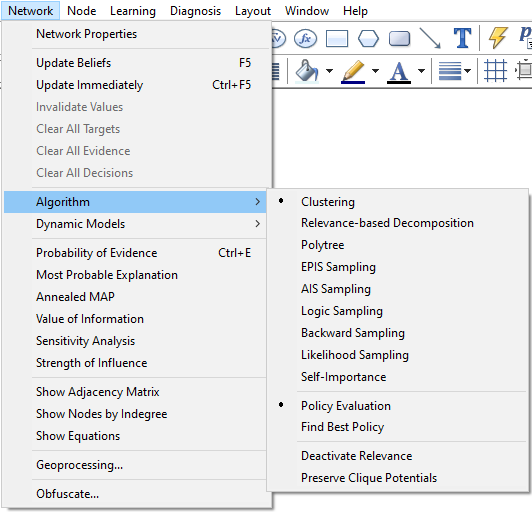GeNIe originates from a research and teaching environment and, as such, has seen the development and use of a variety of algorithms. The user can choose which algorithm should be used for updating by selecting an algorithm from the list displayed in the Network Menu. SMILE and GeNIe implement several popular Bayesian networks inference algorithms, including the clustering algorithm and several stochastic sampling algorithms. There are also two influence diagrams algorithms: policy evaluation and finding the best policy. The motivation for maintaining a pool of algorithms has been historically twofold. Firstly, both GeNIe and SMILE were originally used in research and teaching environments and the algorithms were used for benchmarking and comparative studies. Secondly, even though the clustering algorithm (default in GeNIe) is quite possibly the fastest implementation of this algorithm in existence and the fastest exact algorithm in GeNIe, there are networks for which the memory requirements or the updating time may be not acceptable. In these cases, the user may decide to sacrifice some precision and choose an approximate algorithm. Sampling algorithms are, roughly speaking, based on a statistical technique known as Monte Carlo simulation, in which the model is run through individual trials involving deterministic scenarios. The final result is based on the number of times that individual scenarios were selected in the simulation.
The algorithm pool is under continuous development and improvement. We will list references to literature describing individual algorithms when covering the algorithms. For readers interested in an overview paper on algorithms, we recommend (Huang & Darwiche 1996) and (Henrion 1990). An reasonable overview of stochastic sampling algorithms can be found in (Shachter & Peot 1990) or (Yuan & Druzdzel, 2005).
It is up to GeNIe user (or, in case of SMILE, up to the application programmer) to call the algorithm of his or her choice. Both GeNIe and SMILE use the concept of the default algorithm. In GeNIe, the default algorithm can be chosen using the Network Menu:

The menu allows for choice of the default algorithm (marked with a bullet). Whenever updating takes place, the current default algorithm will be executed. We would like to note that the influence diagram algorithms are based on the Bayesian network algorithms and the choice of a Bayesian network algorithm will have impact on the precision and performance of the influence diagram algorithm.
We would like to stress that the choice of algorithms has one important practical application: When a network cannot be updated using the fastest known exact algorithm, the Clustering algorithm (GeNIe's default), the user can still update the model using an approximate algorithm. Tradeoff between precision and computation time can be controlled by selecting the number of samples. Our recommendation for such cases is the EPIS Sampling algorithm, quite likely the most efficient stochastic sampling algorithm in existence.
With all functionality that needs randomness, GeNIe relies on the JKISS random number generator with a period of 2127 = 1.7 x 1038. This is sufficient for all practical purposes. Non-zero seeds are hashed before they are used to initialize the generator. Zero seed causes the generator to be initialized with the value based on the system clock and, therefore, makes the output of the algorithm using the pseudo-random generator differ across runs.